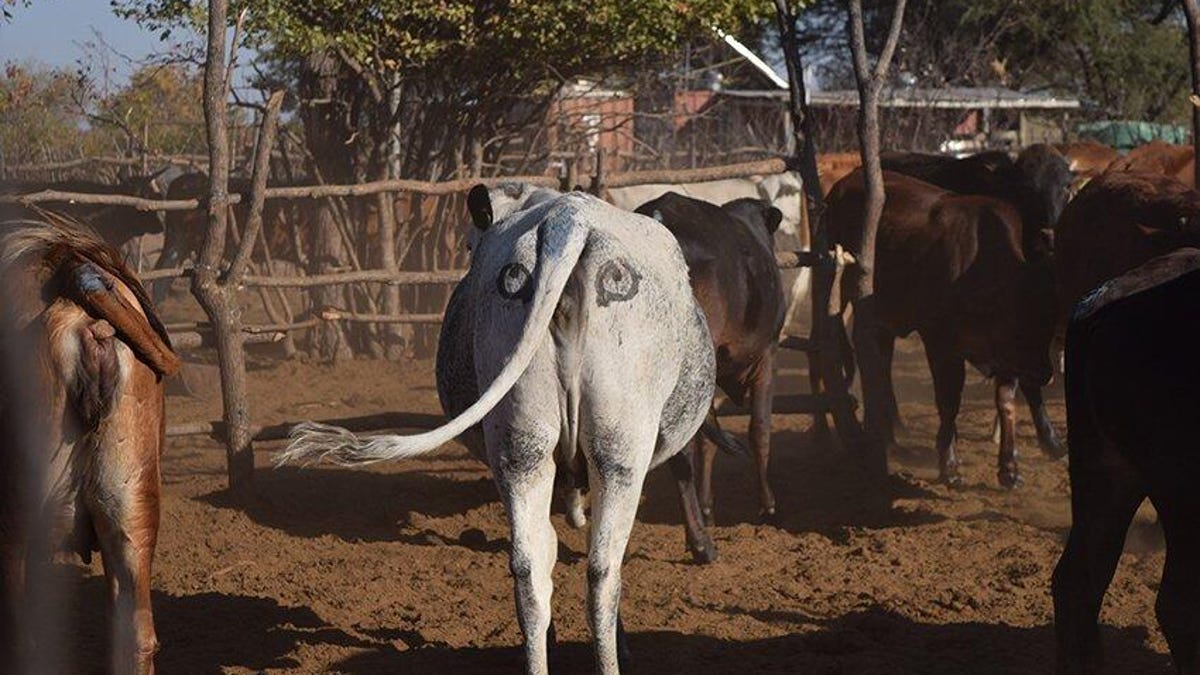Scientists paint eyes on cow butts (for the animals' own good, really)
Talk about hindsight. Drawing eyes on cattle backsides appears to prevent attacks from ambush predators.

Scientists painted eyes on cow butts in Africa to confuse predators like lions.
Painting eyes on cow butts might sound like a prank instigated by bored teenagers, but it's actually a clever tactic ranchers in South Africa are using to help protect their livestock from lions and other ambush predators.
The eyes on the cow rumps could offer a more humane alternative to lethal control (shooting the predators), as well as a more ecological way to protect livestock than using costly fencing to separate the cattle from carnivores.
"Lions are ambush predators that rely on stalking, and therefore the element of surprise, so being seen by their prey can lead to them abandoning the hunt," researcher Neil Jordan, a study co-author from the University of New South Wales in Sydney, Australia, said in a statement.
The eye artwork is applied to one of the cows.
Researchers worked with farmers in the Okavango Delta region of Botswana to paint cattle in 14 herds (with up to 100 cattle per herd) struggling with lion attacks. For their study, the scientists painted one-third of each herd with an eye design on the cows' butts and one-third with simple cross marks. They left the rest without any markings.
The researchers found that cattle painted with artificial eyes were significantly more likely to survive than unpainted or cross-painted control cattle within the same herd. In fact, the cows without eye markings (15 unpainted and four cross-painted cattle) were killed by predators during the four-year study.
"Cattle marked with simple crosses were significantly more likely to survive than were unmarked cattle from the same herd," Jordan said. "Although eye-marked cattle were more likely to survive than the other groups, this general 'conspicuousness' effect suggests that novel cross-marks were better than no marks at all, which was unexpected."
The scientists from UNSW Sydney, Taronga Conservation Society Australia, and Botswana Predator Conservation released their data in a new study published Aug. 7 in the journal Communications Biology.
From behind, this cow looks almost menacing.
Animals using fake eyes to confuse and detract predators is nothing new. Butterflies, fish, mollusks, amphibians and birds have been known to sport eye designs on their bodies to help them survive against other creatures looking for a snack. However, no mammals naturally produce a fake eye design on their bodies to help against attacks.
"To our knowledge, our research is the first time eyespots have been shown to deter large mammalian predators," UNSW Ph.D. student and study co-author Cameron Radford said. "We think this may suggest the presence of an inherent response to eyes that could be exploited to modify behavior in practical situations -- such as to prevent human-wildlife conflicts and reduce criminal activity in humans."
One more great idea from Babar: pic.twitter.com/ZggHiy7ax9
— Dan Burns (@kilroi22) August 21, 2020
Interestingly, painting eyes on animal butts to scare off predators was an idea used in the children's story about the character Babar, who paints eyes on the hind flanks of elephants to scare off rhinoceroses threatening to attack.
Whether or not the scientists found inspiration in the kids' story or came up with the idea on their own, painting eyes on cow butts could end up helping farmers save both money and time in protecting their livestock.
"The eye-cow technique is one of a number of tools that can prevent carnivore-livestock conflict, but no single tool is likely to be a silver bullet," Jordan said. "Indeed we need to do much better than a silver bullet if we are to ensure the successful coexistence of livestock and large carnivores. But we're hoping this simple, low-cost, non-lethal approach could reduce the costs of coexistence for those farmers bearing the brunt."

